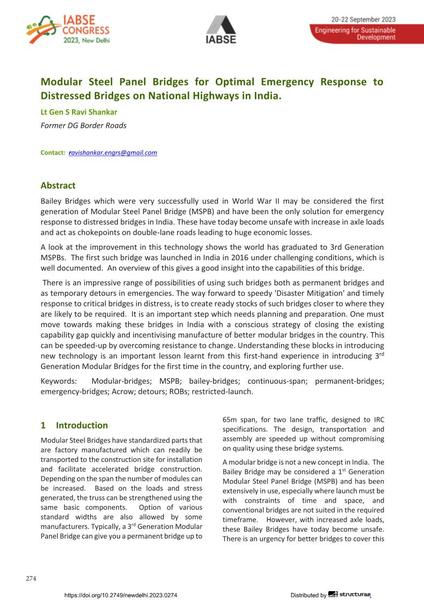Modular Steel Panel Bridges for Optimal Emergency Response to Distressed Bridges on National Highways in India

|
|
|||||||||||
Bibliografische Angaben
| Autor(en): |
S. Ravi Shankar
(Former DG Border Roads)
|
||||
|---|---|---|---|---|---|
| Medium: | Tagungsbeitrag | ||||
| Sprache(n): | Englisch | ||||
| Tagung: | IABSE Congress: Engineering for Sustainable Development, New Delhi, India, 20-22 September 2023 | ||||
| Veröffentlicht in: | IABSE Congress New Delhi 2023 | ||||
|
|||||
| Seite(n): | 274-281 | ||||
| Anzahl der Seiten (im PDF): | 8 | ||||
| DOI: | 10.2749/newdelhi.2023.0274 | ||||
| Abstrakt: |
Bailey Bridges which were very successfully used in World War II may be considered the first generation of Modular Steel Panel Bridge (MSPB} and have been the only solution for emergency response to distressed bridges in India. These have today become unsafe with increase in axle loads and act as chokepoints on double-lane roads leading to huge economic losses. A look at the improvement in this technology shows the world has graduated to 3rd Generation MSPBs. The first such bridge was launched in India in 2016 under challenging conditions, which is well documented. An overview of this gives a good insight into the capabilities of this bridge. There is an impressive range of possibilities of using such bridges both as permanent bridges and as temporary detours in emergencies. The way forward to speedy 'Disaster Mitigation' and timely response to critical bridges in distress, is to create ready stocks of such bridges closer to where they are likely to be required. It is an important step which needs planning and preparation. One must move towards making these bridges in India with a conscious strategy of closing the existing capability gap quickly and incentivising manufacture of better modular bridges in the country. This can be speeded-up by overcoming resistance to change. Understanding these blocks in introducing new technology is an important lesson learnt from this first-hand experience in introducing 3rd Generation Modular Bridges for the first time in the country, and exploring further use. |
||||
